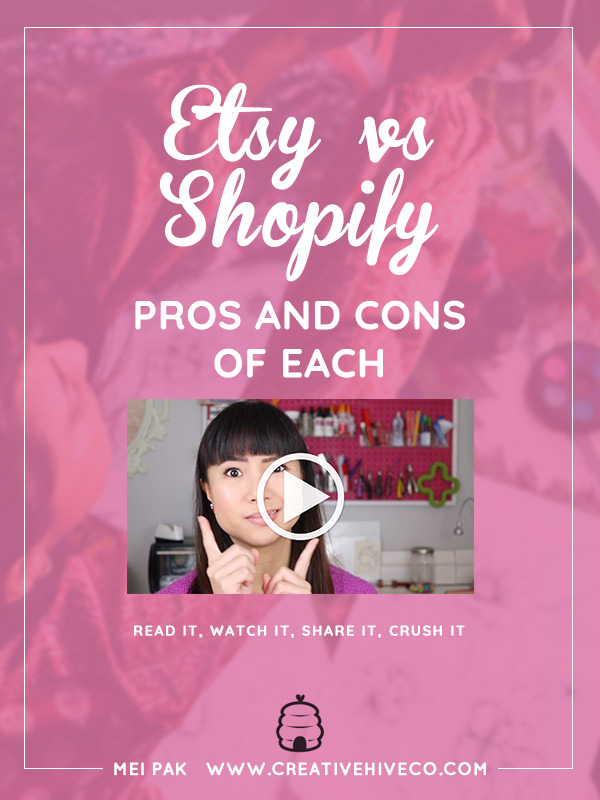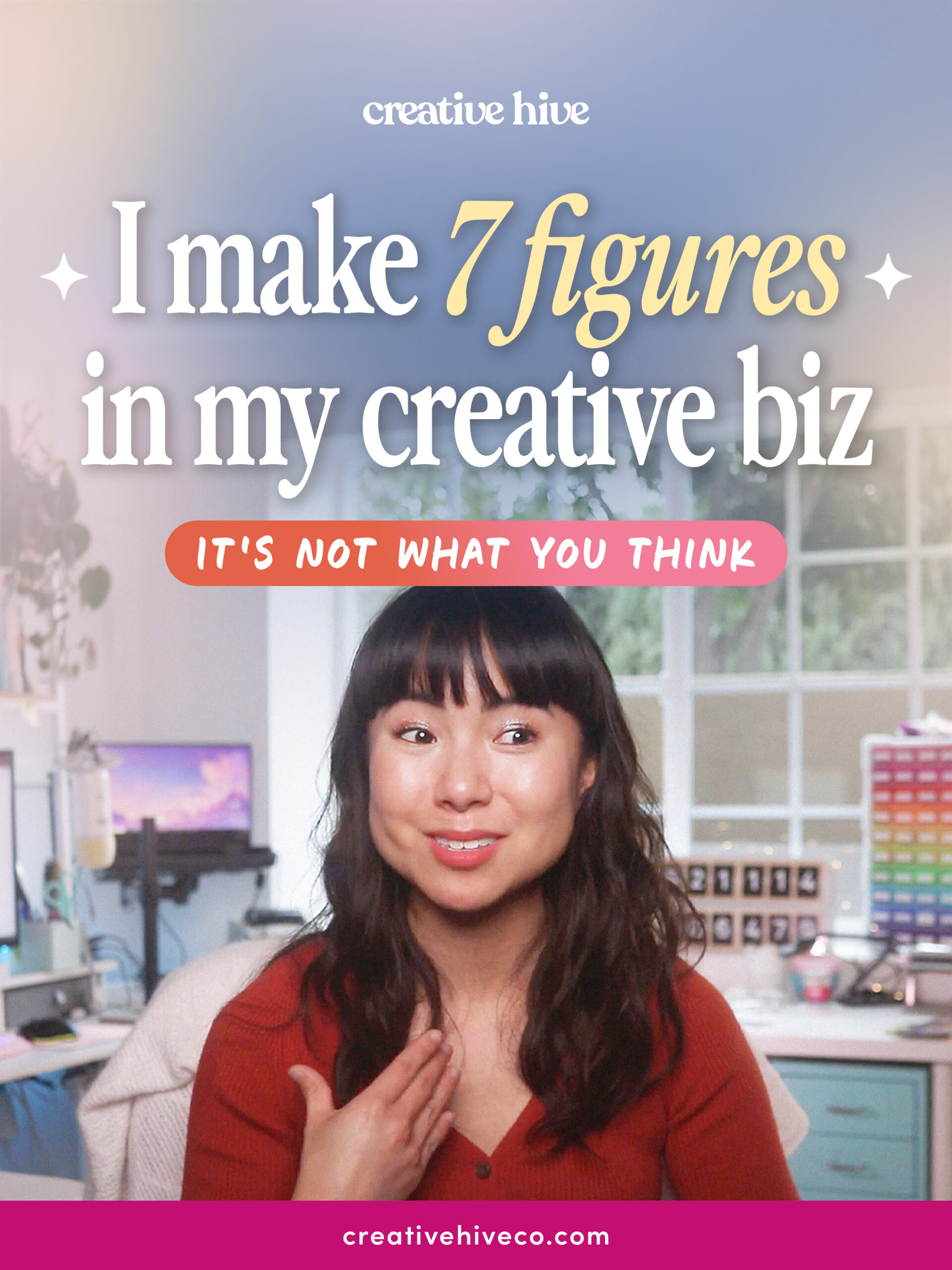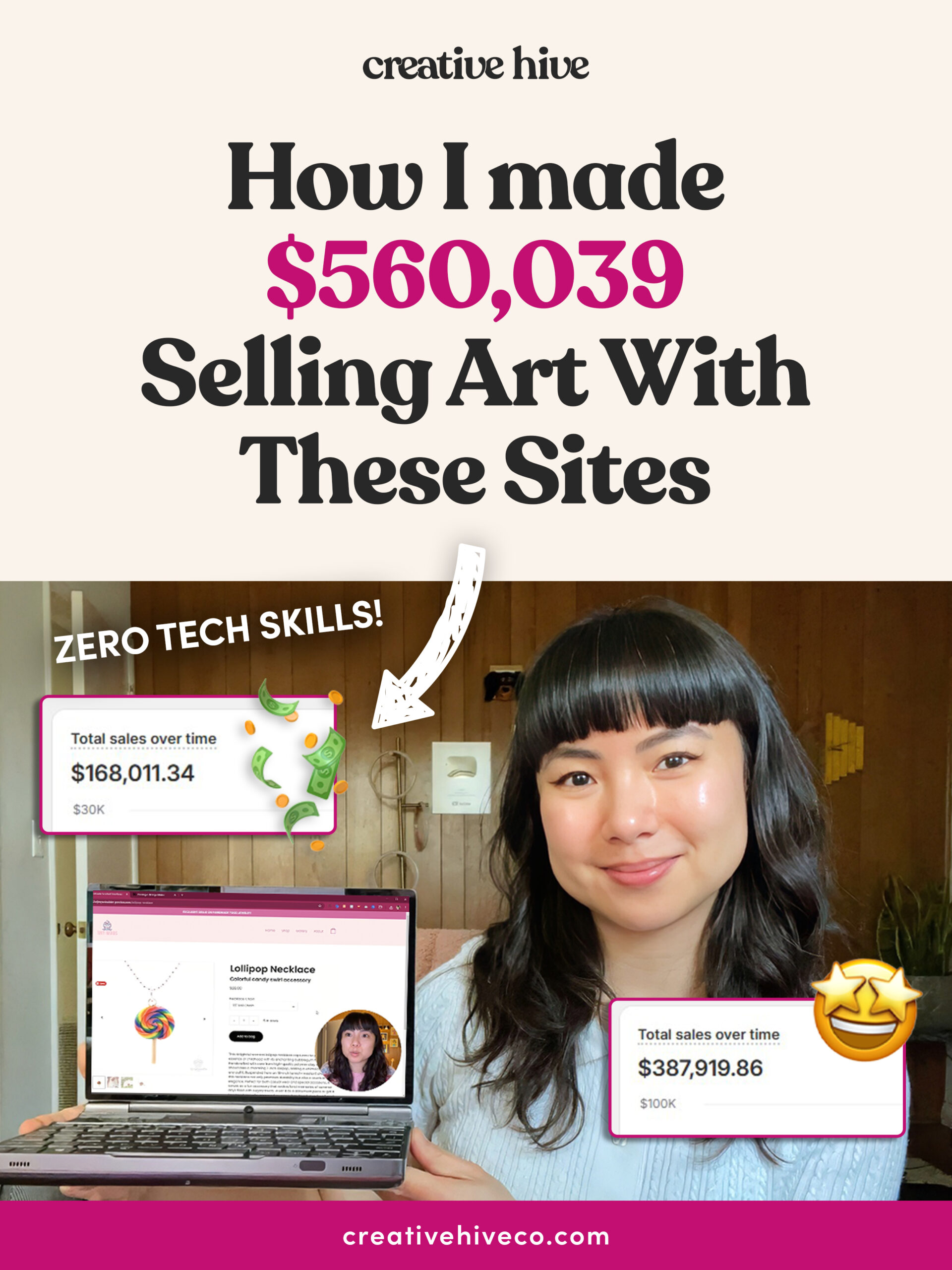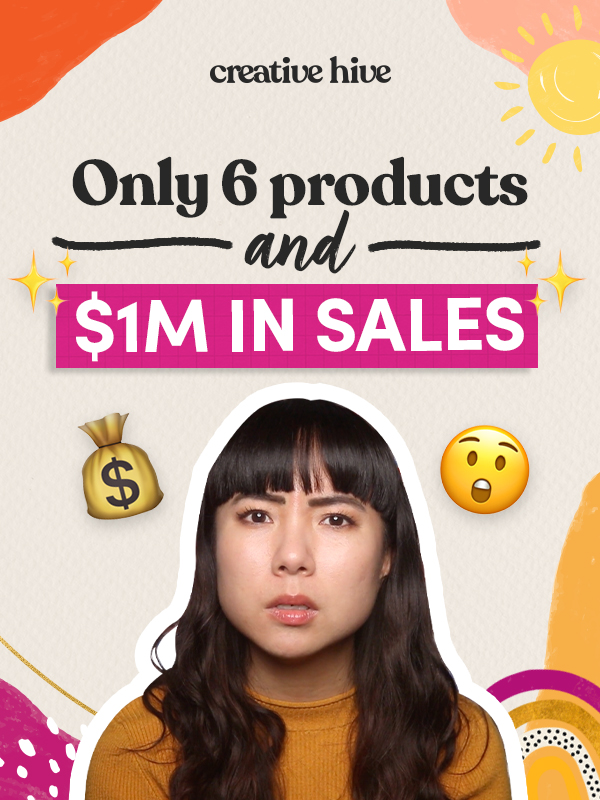I want to help you build a sustainable, profitable handmade business that makes you consistent income and sales. I only ever teach or recommend marketing, social media, pricing, production and branding tips that I’ve personally used successfully in my own 7-figure handmade businesses.
I'm Mei, from Los Angeles!
Read More
Popular Posts You'll Love
Looking for something?
Categories
starting a business
get more traffic
running a business
make more sales
branding
growing a business
mindset & productivity
podcasts
pricing & money
product photography
reviews
selling on etsy
selling on amazon
social media
selling wholesale
- Facebook1
- Twitter1
- Pinterest10
- 12shares
Should you have your own site? Or stay on Etsy?
In this series, I’m going to help you make that decision, and today, I’m going to share with you the pros and cons of both Etsy versus your own website.
I have both an Etsy shop and my own website.
Before I dive in, you first have to understand that Etsy and your own site are completely different models.
Etsy is a marketplace filled with hundreds of thousands of other shops, just like Amazon and Ebay. It’s completely powered by a search engine where people type in stuff that they’re looking to buy (like floral tea towels) and then Etsy gives the person a huge list of floral tea towel products from all the different shops that have them.
Your own website is a standalone site, and if you go with something like Shopify, which I recommend that you do, Shopify is just an ecommerce platform. It’s merely a site builder that makes setting up your own website that people can shop on, so much easier.
Etsy Pro: Built-In Audience
I think the biggest advantage to having a shop on Etsy is because it’s a marketplace site, it has a built-in audience full of people who are already searching for products to buy.
How does Etsy get all this traffic?
Well, part of it is the fees that Etsy takes from sellers, they use that to pay for ads and marketing.
Etsy shops and search listing pages appear really high in Google search.
Part of that and how it gets its traffic is because the hundreds of thousands of shops on Etsy are helping bring traffic to the platform.
When you promote your Etsy shop, you’re inherently also promoting Etsy as a whole, including other Etsy shops, some of them who you might consider your competitors.
But they’re also bringing in traffic of their own and some of them might land on your own shop. So it’s almost like shared traffic, and it can be a double-edged sword.
When you’re on your own site, you don’t have the benefit of starting out with your own built-in audience. I see a lot of people complaining that they set up a shop on Shopify but they didn’t get any traffic or sales.
The mistake is going into Shopify with the expectation that it has that built-in audience. It doesn’t. Shopify is just a website builder that specializes in shops. So if you sell a physical product, Shopify is the best option for you. But it doesn’t have an audience waiting to buy your stuff.

Etsy Pro: Success is Simple with SEO
The primary way of doing well on Etsy is pretty simple.
You have to understand how their search algorithm works, meaning, you have to have an understanding of what factors help you get your listings more visibility and reach. These are things like:
- how new or how recent you renewed your listing
- how much engagement you get on your listing
- are people clicking on your images
- what your click-through rate is
- when your listing appears in a search, how likely is it that people will click on your product instead of other people’s products
There are many factors, and as with any algorithm, there will never be a public list of them because Etsy doesn’t want people to exploit the algorithm and find loopholes to misuse the algorithm for their advantage in a bad way.
A lot of Etsy success comes from understanding search trends and getting really good at SEO, which stands for search engine optimization.
That means researching what keywords to target and putting them in your titles, descriptions, tags and so on.
That is it.
Many successful sellers on Etsy don’t have a large social media following, they don’t have any press mentions, and they don’t have blogs or an email list.
Yes, of course, if you looked at some of the top sellers, you’ll see that many of them have all these things, but you have to ask which was cause and effect?
Which came first?
Did these Etsy shops succeed because they had press mentions, or did they have press mentions because they were already doing well and getting a lot of attention?
Generally speaking, from the patterns I see (and I’ve been selling online for 14 years now) successful Etsy sellers don’t have to worry a lot about marketing.
The way to make sales is a pretty straightforward and simple one.
I’m not saying it’s easy, I’m just saying it’s simple.
Shopify Con: Making Sales can be Complicated
With your own site, that process to make sales is a whole lot more complicated. You can’t just rely on SEO, you have to have a mailing list, do outreach and get press mentions, and it definitely helps to have an engaged social media following.
When it comes to standalone sites, the pattern I’ve seen over and over again, because you know, success leaves clues, is successful shops have a track record of press mentions.
If it’s not that, it’s paid advertising.
Some shops do really well with just SEO, but that’s less common.
So this is a huge disadvantage with having your own site, because you have to worry about a lot more when it comes to marketing it and sending traffic to it, if you want to make sales.
Etsy Pro: It’s Super Easy to Start
An advantage to Etsy is it’s super easy to start with.
If you know anyone who’s starting a handmade business, it’s the first thing most people would recommend.
“You should sell on Etsy!”
There’s validity in that because they do make it easy.
There are no upfront costs besides that $.20 per listing, and they really hold your hand to help you set everything up.
You don’t have to worry about whether or not your shop is loading quickly, or if your website works correctly or not.
Your shop is secure, you don’t have to fuss about your shop design, all you need to do is fill in the blanks with configuring your shop settings on Etsy.
It’s so easy.
Etsy is undoubtedly a great place to learn how to sell online if you’ve never done it before.
It’s like, if you don’t know how to swim, Etsy is like starting at the kiddie pool.

Shopify Con: You Have to Ensure Your Website is Functional
Even though it’s also really easy to set up a Shopify store, it’s not nearly as easy as Etsy and with Shopify, while you don’t have to generally worry about site security, you do have to still consider site speed and the design of your site.
This is where so many people go wrong, especially if you didn’t take the time to learn what makes good site design and what makes it bad.
And unfortunately, it’s all on you.
It’s your responsibility to make sure your site loads quickly, it looks good, and it gives your potential customers a great user experience.
You don’t have to worry about that with Etsy because they’ve already done it for you. You don’t have to worry about conversion rates as much when you’re on Etsy, because the number of factors to consider is far fewer.
For example, on Etsy it’s really just about having good products, getting your photos looking good, and that you have a reasonable price with reasonable shipping and short turnaround time.
That’s about it.
With your own site, however, you have to do ALL of that and more.
You have to consider the checkout process and your site design. Between those two things, a lot can go wrong if you don’t know what you’re doing.
The good news is that when you’re on Shopify, there are a lot of great themes you can use that help make all of this a lot easier for you and it’s almost like a plug and play. You just have to edit the theme with your brand colors.
Even so, there are a lot of Shopify themes that aren’t good, and I’ve seen a lot of shops choosing themes that don’t give them a good conversion rate.
If you set up on Shopify, just make sure you use a theme that’s proven to make sales.
Ask around or check for the theme’s reviews before you install it.
Now, at this point, I know I’ve made Etsy sound like such a dream to work with, but that’s because I haven’t touched on Etsy’s cons yet.
I don’t know if any of these cons are more frustrating than others, so I’d love to hear from you in the comments what your biggest beef is with Etsy. There’s actually a lot to be upset with.
Etsy Con: You Don’t Have Control Over Your Shop
One of the biggest problems with Etsy is you have almost no control over your shop. This is what balances out the ease of use and having that built-in audience.
If you want those awesome things, you have to play by Etsy’s rules.
So they’re going to enforce all sorts of policies on you that you usually can’t opt out of and if you can, your shop will suffer for it.
Recently Etsy wanted to encourage people to offer free shipping for their products, which helps get people to buy. But they made it so that IF you can offer free shipping, you’ll get better rankings on the search engine, which makes it very unfair for anyone who doesn’t offer free shipping, or who CAN’T offer free shipping because they make heavy or big products and they don’t want to add the shipping price to their product price.
It’s a catch 22 because if you raise your prices to include shipping, you now also can’t compete on price and you’re going to seem more expensive than your competition.
It’s just a terrible race to the bottom and it’s cut-throat. It’s a really negative, unhealthy environment to be putting yourself in.
Most recently, we’ve all heard of how Etsy is forcing shops that make over $10,000 per year to pay an extra commission on their sales that were generated through Etsy ads that they do on your behalf.
The worst part of that is, you don’t have a say in it.
Not to mention, whenever Etsy makes design changes on their site, you can’t say yes or no to that. You just have to take it and roll with it.
When Etsy’s algorithm changes, your shop will be affected by it.
Running a shop feels like a roller coaster because sales are inconsistent. Some days you make lots of sales, other days it’s crickets.
That feeling is definitely amplified when you’re on Etsy, because it’s not your own site, it’s not your own platform and you have no control over where the Etsy ship decides to go.
If it sinks, you’re gonna sink with it.
I’ve heard so many stories of Etsy sellers who used to do really well on Etsy making sales consistently, only to suffer and not see any sales for months because of these changes.
Fundamentally, I believe that Etsy is not a good place for you if you’ve decided that you want to make your business a long term commitment. Almost like a lifestyle choice.
If you just want Etsy to be a hobby business for you and it’s not a big deal if your sales ebb and flow, then that’s fine, Etsy will serve you well.
But for those of us who want to or are relying on our business income to pay for our living expenses and to sustain our livelihood, then do not put all your eggs in the Etsy basket.

Shopify Pro: You Control Your Site
So how is it different when you’re on your own site?
You can control about 98% of your site.
When you’re on Shopify you can’t really edit the design of your checkout pages, which is a deliberate choice on Shopify’s behalf because they’re the experts and have so much data to know exactly how to design a checkout process to gives you the best conversions and the most sales. So they don’t really let you fiddle around with that too much.
It’s for your own good.
But for the rest of your site, you can really make it on your own.
For some of you, you may never care to do that, but I think there’s a certain sense of pride we have in the packaging of our products. I mean, just because you’ve made a good product, doesn’t mean we have to stop at that. We spend a lot of time getting good packaging for it, designing pretty business cards.
Making your site look good to represent your product in the best way is the same thing.
Some of us want that control and to have the ability to change that, and I think that’s one of the keys to making more sales.
It’s like how when you go into a nice hotel, you get better service, better food, a beautiful room with comfortable bed sheets and a nice pool and so on.
It’s all about the experience.
Versus if you went to a dinky motel, the experience overall will be less enjoyable.
Your Etsy shop will always be the same, it’s what Etsy gives you and it’s not exactly a high end five-star hotel.
Your own site can be polished up or down however you want it. If you want your site to be a three-star hotel, you can make it so. If you want it to be a five-star hotel, you can do that too.
You have the choice.
Shopify Pro: You Can Communicate Your Brand Better
Your own site is better at communicating your brand to the customer than Etsy ever will.
100% of the time, people buy things on Etsy and don’t remember what the actual shop name was.
If their friends ask them where they bought their pretty necklace or their cool wall art, they’re going to say they got it from Etsy.
This doesn’t do YOUR brand any favors.
So when you send traffic to your Etsy shop, you’re inadvertently sending ETSY your traffic.
It’s that shared traffic concept I talked about earlier. You maybe get 20% of the traffic you actually send to your Etsy shop, but Etsy and all the other shops on there get the majority 80% of your traffic.
This is why, over time, Etsy has all that built-in audience.
You helped them grow.
Which is in itself not a bad thing, but you could have gotten 100% of all your own traffic if you had directed them to your own site.
One of my pet peeves with Etsy’s product listings is when you scroll down, Etsy shows you listings from other people’s shops, directly on my own listing. I get why they do that. Etsy’s number one priority is to make sales, and they don’t care if that sale was for your shop or someone else’s shop.
Directing your own traffic to Etsy is like trying to collect water with a leaky bucket. You’re putting water in it, but so much of it just leaks right out.
Etsy Con: Competition is Crazy
The competition on Etsy is crazy. Etsy rewards shops and product listings that are already doing well, so there’s a lot of pressure to make sales not just because you want to make a sale but because you want to get on Etsy’s good side and start ranking better for your targeted keywords.
So what do people do?
They try to make their product listings stand out so people click on them. But even then, that’s no longer enough, so then they succumb to a pricing war.
“If I charge less than other people’s listings, it’s more likely that I’ll make the sale. And later Etsy will push my product more.”
If you’re thinking that way, I can guarantee you your competitors are also thinking that way. So they start to charge even less.
It just goes on and on and it becomes a race to the bottom.
I wish I could tell you that people don’t price shop, but on marketplace sites, prices and reviews are two of the biggest factors that people go off of when deciding on which item to buy.
If you’re not the lowest price with the best review, it’s going to be really hard.

Shopify Pro: Competition is Less Severe
Let’s compare that with your own website. Yes, there will always be competition no matter where you are, on Etsy or Amazon or on your own site or at a craft show.
What I want you to pay attention to, is the degree of the competition.
The competition on Etsy is on your own shop, but when people come to your site you can keep them on your site for much longer because you’re not sending them away to go look at your competitor’s shops.
You can design your site in a way that gets people engaging and sticking around longer.
It’s a lot more effort for people to go to a different shop that sells something similar to you if they can even find one to begin with.
Or take for instance someone who found you on Instagram.
They loved your work and clicked on your link in bio to go check out your site. They’re on your site. Your site is essentially a dead end.
If they like what they see, they’ll buy something, join your email list, bookmark your site, or follow your Instagram.
But if they wanted to find another shop like you, how are they going to do that? It’s not so easy. They have to start a search on Google or go back to Instagram to try to find something similar.
There’s no long term brand awareness when you’re on Etsy. You might get some repeat sales on Etsy, but you get to have a lot more with your own site.
This goes back to people not knowing your shop name when they buy from you. This is a huge detriment to building long term success and growth.
You’re always starting from scratch to make those sales.
Whereas if you had your own site, where you could give it a custom brand and a unique and positive shopping experience for your customers, they’re going to remember you so much better.
Which makes it so that word of mouth later is more effective.
People are saying, “I love Tiny Hands” to their friends. Not “I love Etsy”, which only helps Etsy, and not you. You’re not getting the proper credit that you’re due on Etsy.
So while having your own website might feel like it’s harder and slower to make sales in the beginning, in the long run, you’re going to be the last man or woman standing because every effort you make to promote your shop, 100% of it goes to you.
It’s like building equity. You don’t get to build equity when you’re in a rented property, which is what Etsy is.
Shopify & Etsy Cons: Fees
When it comes to fees, both ways are expensive.
You might say Etsy has high fees but honestly, so does selling on your own site.
It’s generally just expensive and it’s getting more expensive over the years, to run a business. So that’s just a part of the process now.

Leave a Comment
Liked this article? Share it!
Unlock a Profitable Handmade Business
in Just 12 Weeks Without Using Etsy
or Social Media
FREE WORKSHOP
This workshop is for anyone who makes and sells a handmade or physical product, including jewelry designers, artists, paper designers, bath & body product makers and more!
What You'll Discover
The #1 mistake people make with Etsy & social media that causes shops to FLOP
The secret to making it with your handmade shop so it's no longer just a hobby
How to make sales in your handmade shop with ease so you can finally get to 6-figures
TAKE ME THERE
Your email address will not be published. Required fields are marked *
Leave a Reply Cancel reply
About
Blog
A Sale A Day
Student Login
Free Class
Contact
Terms
Become A Student
Watch On YouTube
Student Reviews
See My Handmade Shop!



Hi – I left a comment, but not sure where it went.
Thank you for all the great information. I began on Etsy about 9 years ago. Put my shop on vacation and built my own Shopify site about 4-5 years ago. I feel confident after listening to the video that staying with my own website is what’s best if I’m serious about my brand. I need to continue to make the website more professional, better photos, etc. and will work on it. Do you have any videos on how to give your Shopify website a more professional look.
Nancy